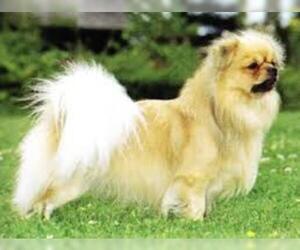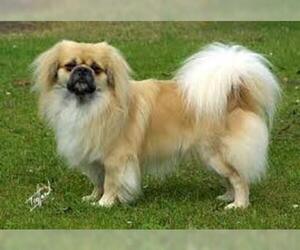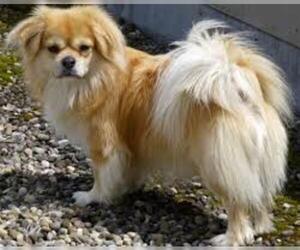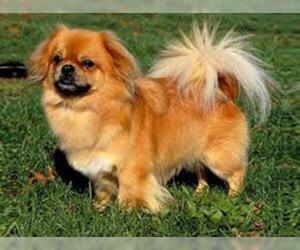
All about Tibetan Spaniel dog breed
A.K.A. :Tibbie, Tibetan Lion Dog, Phalène Tibetain, Kleine Tibetaanse Hond, Zwergspaniel Tibetain, Tibetansk Spaniel
Size
Grooming requirements
Exercise requirements
Good with other dogs
Watchdog ability
Energetic
Training requirements
Playful
Affectionate
Good with other pets
Good with children
Good with strangers
Winter
Summer
Healthiness
Protective
Life Span
| Pure Breeds | Member |
| Breeds A - Z | T |
| Breeds by Group | Companion Non-Sporting |
| Breeds by Trait | Good With Kids Low Shedding |
| Overview: | The Tibetan Spaniel is a charming and ancient breed, originating in the mountainous regions of Tibet where they were revered companions in monasteries. Despite their name, they are not true spaniels but rather a "temple dog" or "lion dog," sharing ancestry with breeds like the Pekingese and Lhasa Apso. Physically, they are small, well-proportioned dogs with a distinctive "lion-like" mane around their neck, a plumed tail carried over their back, and a double coat that comes in a variety of colors. Their expression is often described as alert and intelligent. Temperamentally, Tibbies are known for being playful, affectionate, and fiercely loyal to their families, though they can be reserved with strangers – excellent watchdogs despite their size. They adapt well to various living situations, making them suitable for apartment living as long as they receive regular walks and mental stimulation. Generally a healthy breed, they are prone to certain genetic conditions like patellar luxation, progressive retinal atrophy (PRA), and primary lens luxation (PLL), so reputable breeding is crucial. Their relatively low grooming needs and friendly nature make them wonderful companions for many households. |
F.A.Q.
All You Need to Know About the Tibetan Spaniel Breed
The Tibetan Spaniel is a charming, small companion dog originating from the Himalayan mountains, where they served as monastery watchdogs and loving lap companions. Known for their intelligent, independent, and affectionate temperament, these "Tibbies" make wonderful family pets. They boast a lion-like mane, a plumed tail, and a distinctive "oriental" expression. Their moderate double coat requires weekly brushing, with minimal shedding, and their exercise needs are modest, making them ideal for apartment living and seniors. They thrive on human companionship and are generally good with children and other pets when properly socialized. While relatively healthy, common health considerations include luxating patellas and progressive retinal atrophy. If you're seeking a loyal, bright, and low-maintenance furry friend, the Tibetan Spaniel could be your perfect match!The average weight for a Tibetan Spaniel is typically 9-15 pounds. While there isn't a significant weight difference between sexes, some males may be slightly heavier than females. Maintaining a healthy weight for your Tibetan Spaniel within this range is crucial for their well-being.
What is the average height of a Tibetan Spaniel in inches?
Curious about the typical Tibetan Spaniel height? These charming little dogs usually stand between 10 to 11 inches tall at the shoulder. This measurement represents the average adult size for a healthy Tibetan Spaniel. While there isn't a significant difference in height between males and females, individual genetics can cause slight variations within this range. So, when asking "how tall is a Tibetan Spaniel," expect them to be around this petite and manageable height! This makes them a great choice for those looking for an affectionate companion with a relatively compact build.The Tibetan Spaniel breed exhibits a wide array of beautiful Tibetan Spaniel colors, making each dog unique. While all colors and markings are acceptable by major kennel clubs like the AKC, there are common and less common variations to be aware of.Commonly seen and AKC recognized Tibetan Spaniel colors include black, white, gold, cream, sable, and red. You'll also find lovely variations such as brindle (tiger-striped patterns), fawn (light tan to reddish-brown), and parti-color (patches of two or more colors, often white with another color). Many Tibbies also display distinct markings, including black masks or white markings on the chest and paws, which are all within the breed standard.While extremely rare and not typically sought after by breeders aiming for show conformation due to their genetic implications, some breeders may occasionally produce exotic Tibetan Spaniel variations or rare coat types such as blue (diluted black, appearing grey), lilac (diluted chocolate), merle (patchy dilution of base color, often associated with health issues in some breeds), or chocolate (brown). It's important to note that these "dilute" or "non-standard" colors, while genetically possible, are not generally promoted or specifically mentioned as desired traits by the AKC breed standard for the Tibetan Spaniel, which states "All colors and mixtures of colors are permissible." Potential adopters interested in these very rare coat types should research the specific genetic lines and be aware that such unique colorings do not typically command higher pricing for breed purity but rather for their rarity and aesthetic appeal to some individuals.
Tibetan Spaniel Personality & TemperamentThe Tibetan Spaniel personality is a delightful blend of independent spirit and affectionate companionship. These charming small dogs possess a temperament of Tibetan Spaniel that is generally joyful, intelligent, and highly social. They are known for their friendly and outgoing nature, often greeting strangers with cautious curiosity before warming up quickly.Loyalty is a hallmark of the Tibetan Spaniel; they form strong bonds with their families and thrive on human interaction, preferring to be an integral part of daily activities. Their intelligence makes them capable of learning quickly, though their independent streak can sometimes translate into a mischievous or "cat-like" determination to do things their own way.Tibetan Spaniels are highly sociable, enjoying the company of people and often other pets. They are typically good with children, especially those who are gentle and respectful, and often enjoy playful interactions. They generally get along well with other pets, including cats, particularly if introduced at a young age.Regarding living arrangements, the Tibetan Spaniel is remarkably adaptable and an excellent choice for apartment living. While they appreciate a good romp in a secure area, their exercise needs are moderate, and they are content with daily walks and indoor play. Their alert nature makes them good watchdogs, readily announcing visitors, but they are not typically excessive barkers. They are sensitive to their owner's moods and generally want to please, making them delightful companions for a wide range of lifestyles.
Tibetan Spaniel Temperament & Personality TraitsThe Tibetan Spaniel temperament is a delightful blend of independent spirit and devoted companionship, making them a wonderful companion dog behavior. These small, charming dogs are generally friendly and sociable with their families and known acquaintances, often greeting them with enthusiasm. While they enjoy human interaction, they also possess a charming self-sufficiency, content to observe from a comfortable perch.Tibetan Spaniels are exceptionally loyal to their owners, forming strong bonds and thriving on close companionship. They are surprisingly adaptable to apartment living due to their relatively moderate exercise needs and compact size, as long as they receive daily walks and mental stimulation.Regarding their behavior with children, Tibetan Spaniels are generally good-natured and tolerant, especially if raised with them. However, like all small breeds, supervision is recommended with very young children to ensure respectful interactions. They can coexist peacefully with other pets, particularly if socialized from a young age, though some may exhibit a typical "big dog in a small body" confidence around larger animals.While intelligent, Tibetan Spaniels can sometimes display a touch of stubbornness, a characteristic often linked to their independent nature. Positive reinforcement and patience are key to successful training. They are also relatively sensitive dogs and respond best to gentle handling and consistent, kind communication. Overall, the Tibetan Spaniel is a bright, affectionate, and engaging companion, bringing joy and a unique personality to their home.
Tibetan Spaniel Care: Daily Maintenance & Health TipsTibetan Spaniel care is relatively straightforward, making them a great companion for various lifestyles. Grooming needs are moderate; their double coat requires weekly brushing to prevent mats and minimize shedding. Expect heavier shedding twice a year. Regular nail trims are essential.Exercise limitations make them a low-energy dog breed. A short daily walk and indoor play are typically sufficient to meet their activity needs. They are adaptable to apartment living.Dietary considerations involve feeding a high-quality dog food appropriate for their age and activity level. Weight management is crucial as they can be prone to obesity; avoid overfeeding and excessive treats.Due to their brachycephalic anatomy, wrinkle and ear cleaning are vital. Clean facial folds daily to prevent skin irritation and infections. Check and clean their ears weekly to avoid buildup. Climate sensitivity means they struggle in extreme heat; ensure they have shade and access to water, and limit strenuous activity during hot weather.Common health concerns include skin issues (often related to uncleaned wrinkles), dental care needs (regular brushing and professional cleanings are important to prevent periodontal disease), and patellar luxation. Proactive how to care for a Tibetan Spaniel involves regular vet check-ups to monitor overall health.
The Tibetan Spaniel activity level is moderate, balancing short bursts of energy with long periods of rest. They are not high-energy dogs, but they do enjoy and require daily exercise needs. Typical energy levels involve playful romps indoors or in a secure yard, followed by extended naps. About 20-30 minutes of daily activity, like short walks or playtime, is usually sufficient to keep them content and healthy.How active are Tibetan Spaniel? They love to play with toys and engage with their families, but they're also happy to cuddle on the couch. Their playtime preferences include fetch, tug-of-war, and exploring a yard.It's crucial to be aware of limitations due to their brachycephalic anatomy. Like all flat-faced breeds, Tibetan Spaniels can overheat easily, especially in warm weather or during strenuous exercise. Always supervise them, provide ample water, and avoid activity during the hottest parts of the day.This breed is highly adaptable and can be suitable for both low-energy households and moderately active families. While they enjoy accompanying you on short adventures, they are generally not ideal for highly active families seeking a dog for long hikes or intense sports. They thrive in environments where their bursts of energy are met with equally valued downtime and companionship.
Due to their compact build and facial anatomy, Tibetan Spaniels are also prone to heat sensitivity, especially in warm climates or during vigorous activity. Providing shade, hydration, and rest breaks is essential. Spinal problems such as arthritis or degenerative disc disease may occur with age or poor conditioning, particularly in dogs with limited mobility or excess weight.
Understanding how to keep Tibetan Spaniel healthy involves regular veterinary checkups, early screening for joint, eye, and liver conditions, consistent grooming to manage coat and skin hygiene, weight control, and gentle exercise routines. With attentive care, Tibetan Spaniels can enjoy a cheerful, affectionate life of 12–15 years.
Breed Breakdown: What Experts Say About the Tibetan Spaniel
I would rate the "Size" trait of the Tibetan Spaniel as a 3.Tibetan Spaniels are a distinctly small breed. They typically stand between 10 and 12 inches tall at the shoulder and weigh around 9 to 15 pounds, with a sturdy but compact body structure. When compared to the vast array of dog breeds, they fall squarely into the toy or small breed category. Their diminutive stature makes them exceptionally well-suited for apartment living, frequent travel, and households with limited space. They are very manageable to pick up and carry, and their presence doesn't demand a large footprint, making them a fantastic choice for those who prioritize a compact canine companion.
I would rate the grooming requirements of the Tibetan Spaniel a 3 out of 10.Tibetan Spaniels are generally quite low-maintenance in terms of grooming. Their double coat, while moderate in length, is silky and doesn't tend to mat easily, especially if brushed a couple of times a week. They are moderate, seasonal shredders, meaning you'll see more hair during certain times of the year, but regular brushing helps manage this. They typically don't have skin folds requiring special care. Ear cleaning is standard, needing a check and wipe weekly or bi-weekly, and nail trimming is typical for any dog, needing attention every few weeks. Bathing is only necessary when they are visibly dirty, perhaps every 4-8 weeks, as their coat repels dirt fairly well. They are not particularly prone to skin issues or allergies, making their overall care straightforward and not requiring frequent, specialized grooming compared to many other companion dogs.
I would rate the Tibetan Spaniel's "Exercise Requirements" at a 3.Tibetan Spaniels have relatively low to moderate exercise needs, falling far from the high-energy demands of many other breeds. While they are playful and enjoy short bursts of activity, their brachycephalic (short-nosed) anatomy means they are not built for sustained or strenuous exercise, especially in warm weather. Daily walks of 20-30 minutes, combined with indoor playtime and mental stimulation through toys or training, are usually sufficient to keep them healthy and happy. They thrive with a comfortable balance of activity and relaxation, making them well-suited for apartment living or owners who prefer a more laid-back companion. They don't require structured, high-intensity routines, and attempting to push them into such activities could be detrimental to their health due to their respiratory limitations. They are content with being a part of family life, enjoying gentle walks and engaging in short, fun play sessions.
The Tibetan Spaniel's "Watchdog Ability" rates a 7 out of 10.Tibetan Spaniels are surprisingly excellent watchdogs, especially considering their small size. They are highly alert and possess keen senses, quick to notice anything out of the ordinary in their environment. Their primary method of "deterrence" is their persistent and often surprisingly deep bark, which they employ readily and enthusiastically when an unfamiliar sound, person, or vehicle approaches. They have a definite territorial instinct regarding their home and family, and will make it known that someone is there. While they aren't guard dogs in the sense of physically confronting an intruder, they are exceptionally effective at providing loud and meaningful early warnings, making it nearly impossible for anyone to approach the house unnoticed. They are more than just passive companions; they are vigilant sentinels that will undoubtedly alert their owners to any potential threats, acting as excellent "doorbell" dogs.
I would rate the "Good with Other Dogs" trait of the Tibetan Spaniel a 7 out of 10.Tibetan Spaniels are generally known for being good with other dogs, especially when properly socialized from a young age. They are not typically aggressive or dominant and can often adapt well to multi-dog households. Their history as companions in monasteries, where they lived alongside other dogs, contributes to this inherent sociability. They tend to be respectful of other dogs' space and don't usually instigate conflict.However, a rating of 7 rather than a perfect 10 acknowledges a few nuances. While generally friendly, individual personalities and early socialization play a significant role. A less socialized Tibbie might be a bit reserved or initially wary around boisterous or unfamiliar dogs, particularly those with very high energy levels that might overwhelm their more sedate nature. They might not always thrive with extremely pushy or dominant breeds if not given appropriate boundaries. Careful introductions are still beneficial, as they appreciate a calm approach. They are generally compatible with dogs of various sizes, often adjusting their play style, but their smaller size means very large, rambunctious dogs could accidentally injure them, making supervision important. They thrive in canine company, enjoying the companionship, but they do require a foundation of good early socialization to truly blossom into their full dog-friendly potential.
I would rate the Tibetan Spaniel's "Energetic" trait as a 4 out of 10.While not a couch potato, the Tibetan Spaniel is far from a high-energy breed. They possess a moderate activity level, enjoying short bursts of playful antics and daily walks, but are generally more laid-back compared to many other companion dogs. Their endurance is modest; they are content with a good stroll around the neighborhood or some playtime in a secure yard, but won't typically demand or excel in long, strenuous hikes or competitive athletic events. Their need for physical stimulation is manageable, satisfied by regular interaction and mental enrichment through toys or short training sessions rather than intense exercise.The Tibetan Spaniel's brachycephalic (short-nosed) anatomy plays a significant role in limiting their stamina and exercise tolerance. This facial structure can make breathing more difficult, especially during intense or prolonged physical activity, and in warmer weather. Consequently, they are not built for extensive outdoor or athletic pursuits and should be carefully monitored to prevent overheating or respiratory distress during exercise. They are generally more suited to a lifestyle that includes moderate activity interspersed with plenty of rest and indoor comfort.
I'd rate the "Training Requirements" of the Tibetan Spaniel a 5. They are intelligent dogs, capable of learning a wide range of commands and house rules, which might suggest an easier rating. However, their intelligence is often coupled with an independent and sometimes stubborn streak, a characteristic common in many ancient breeds. While they are generally eager to please their beloved humans, particularly for a treat or a cuddle, their attention span can waver, especially if something more interesting catches their eye. Responsiveness to commands can vary; in a quiet, familiar environment, they might be quite compliant, but in a distracting setting, their selective hearing can kick in. This breed absolutely thrives on consistency; an owner who is firm, fair, and provides a clear routine will see the best results. They respond beautifully to positive reinforcement and gentle methods, as harsh corrections can make them retreat or become even more obstinate. While not highly demanding, they are also not a "train themselves" type of dog. They are generally beginner-friendly, provided the new owner is committed to consistent, positive training and understands that patience is key. Experienced handling isn't strictly necessary, but an understanding of canine psychology and the ability to maintain structured routines will certainly lead to a well-behaved and happy Tibbie.
I would rate the Tibetan Spaniel's "Playful" trait as an 8 out of 10.Tibetan Spaniels are generally a spirited and charming breed, not to be mistaken for couch potatoes. They possess a delightful blend of independent thought and a genuine love for interaction. While they aren't the relentless fetch-obsessed type, they show significant enthusiasm for games, especially those involving their human companions. They often initiate play by bringing toys or nudging for attention, and their intelligent eyes sparkle with a desire to engage. During playtime, they can be surprisingly agile and quick, enjoying a good romp around the house or yard. They respond well to toys, often carrying them around and "showing them off." While they appreciate their independence and downtime, their overall enthusiasm in daily life is high, and they thrive on being a part of family activities. They are more naturally spirited and less laid-back than some truly sedentary companion breeds, consistently demonstrating their fun-loving nature.
I would rate the "Affectionate" trait of the Tibetan Spaniel breed a 9 out of 10.Tibetan Spaniels are highly people-oriented and thrive on human companionship, often forming incredibly strong bonds with their families. They are known for their strong desire for physical closeness, frequently seeking out laps for cuddles, snuggling under blankets, and generally enjoying being near their beloved humans. Their loyalty is unwavering, and they are remarkably sensitive to their owner's emotions, often offering comfort with a gentle nudge or a watchful gaze. You can expect a Tibetan Spaniel to follow family members from room to room, acting as a devoted shadow. While they possess an independent spirit that prevents them from being overly clingy or prone to separation anxiety if well-adjusted, their primary motivation is to be an integrated and cherished member of the household, soaking up all the affection they can get. They are not the type of dog to be content simply observing; they want to be actively involved and loved.
I would rate the "Good with Other Pets" trait of the Tibetan Spaniel breed as an 8 out of 10.Tibetan Spaniels generally possess a remarkably adaptable and friendly nature, extending to other animals. They typically get along well with other dogs, often enjoying their company, and are known for their ability to coexist peacefully with cats. Their prey drive is generally low, especially compared to many other breeds, which significantly reduces the likelihood of them chasing or harming smaller pets. While they can exhibit some mild resource guarding, particularly with cherished toys or food, this is usually manageable with early training and doesn't typically escalate to aggression in a multi-pet household. They thrive on companionship and are naturally sociable, making them excellent candidates for homes with other animals. Early socialization, as with any breed, will certainly enhance their ability to integrate seamlessly, but they tend to be naturally inclined towards peaceful coexistence, often requiring less intensive training and supervision than many other breeds to get along with their furry housemates.
Rating: 6The Tibetan Spaniel can be a good companion for families with children, but they aren't universally suited for all households, hence the moderate rating. Their temperament is generally cheerful, intelligent, and affectionate with their own family, and they do enjoy being involved in family activities. However, they are also known for being a bit independent and can have a stubborn streak. They are not typically described as boisterous or overly playful in the way some retriever breeds are, preferring to cuddle on the couch or play more sedate games.Their patience level with very young, boisterous children can be limited. While generally tolerant of handling, they can be sensitive to rough play or sudden, loud noises, and may retreat if overwhelmed rather than showing aggression. For this reason, they are often better suited to families with older, more considerate children who understand how to interact gently with a small dog. They are not naturally gentle and affectionate with strangers or those who don't respect their boundaries, and while they can bond strongly with their family, they may require some supervision to ensure positive interactions, especially when children are very young. Training children on appropriate dog interaction is crucial, as is early socialization for the Tibbie. They are not a "bomb-proof" child-friendly dog, but with the right family dynamics and understanding, they can certainly thrive.
The Tibetan Spaniel's "Good with Strangers" trait would be rated a 6 out of 10.While not inherently aggressive or fearful, Tibetan Spaniels are generally more reserved and discerning with new people than overtly enthusiastic greeters. They possess a keen awareness of their surroundings and new individuals, often taking a moment to observe before approaching. Their historical role as "little lion dogs" in monasteries gave them a watch-dog tendency, leading to an initial aloofness or even a series of barks to alert their family to an unfamiliar presence. However, once they assess a stranger as non-threatening, their friendliness gradually emerges. They are adaptable in public environments as long as they feel secure with their owners, but they aren't typically the type to solicit attention from every passerby. They aren't naturally outgoing in the way some retriever breeds are, and while early and consistent socialization is crucial to ensure they are comfortable and polite with strangers, it's more about building confidence and acceptance than overcoming deep-seated shyness. Without proper socialization, they can lean towards being more barky or reserved, but with it, they generally become politely accepting and even affectionate once they've had a chance to evaluate.
I would rate the Tibetan Spaniel's "Winter" tolerance at a 4.While they possess a double coat, which offers some insulation, it's not exceptionally thick, nor do they carry a significant amount of body fat to provide substantial warmth. Their small size makes them more susceptible to heat loss, and their brachycephalic (short-nosed) anatomy can make breathing difficult in very cold, dry air, potentially leading to respiratory issues or exacerbating existing ones. This breed is at a moderate risk of hypothermia if exposed to cold temperatures for extended periods, especially in windy or wet conditions. They can enjoy brief outdoor activities in moderately cold climates, but prolonged exposure in true winter conditions (freezing temperatures, snow, ice) is not advisable for their safety and comfort.Compared to many other companion dogs, Tibetan Spaniels do require special care during winter months. Their small size and moderate coat mean they will likely need a warm sweater or coat for outdoor excursions when temperatures drop below freezing. Owners should be mindful of the length of time they spend outside and avoid prolonged exposure, particularly on very cold or windy days. Paw protection (booties) might also be beneficial on icy or salted surfaces. They are not built for vigorous winter sports or long hikes in snowy conditions, and their outdoor time should be carefully monitored to prevent discomfort or health risks.
I would rate the Tibetan Spaniel's "summer" tolerance as a 4.While not as severely brachycephalic as some breeds, the Tibetan Spaniel does possess a somewhat flattened face, which inherently compromises their ability to efficiently cool themselves through panting. This anatomical feature, combined with their dense double coat (even if it's not excessively long), makes them less adept at regulating body temperature in warm weather. They are at a moderate to high risk of heatstroke, especially during peak summer temperatures or strenuous activity. Outdoor activity needs to be significantly curtailed during hot parts of the day, limited to early mornings or late evenings, and should consist of gentle walks rather than vigorous play. They absolutely require climate control during hot weather; air conditioning is often essential to prevent overheating, and they should never be left unsupervised in a hot environment, even for a short period. Compared to many other companion dogs, Tibetan Spaniels do require special care in summer months, including strict monitoring, ample access to shade and water, and avoiding direct sun exposure during warm hours. They are not a breed that can simply be left out to play on a hot day without significant risk.
I would rate the Tibetan Spaniel's "Healthiness" trait as an 8. Tibetan Spaniels are generally considered a robust and healthy breed with a relatively long life expectancy, often reaching 12 to 15 years, and sometimes even longer. They are not prone to the severe breathing difficulties seen in some brachycephalic breeds, nor do they commonly suffer from widespread joint problems like some larger breeds. While they can have some genetic predispositions, such as Progressive Retinal Atrophy (PRA) and luxating patellas, responsible breeders actively screen their dogs for these conditions, significantly reducing their prevalence. They are not typically high-maintenance in terms of health, often requiring standard veterinary care and preventive measures. Compared to many other companion dogs, they are quite hardy and generally free from chronic health issues, although like all breeds, they can develop common ailments like dental disease if not properly cared for. Their overall resilience and relatively low incidence of serious breed-specific health problems contribute to this strong rating.
I would rate the "Protective" trait of the Tibetan Spaniel breed at a 5.Tibetan Spaniels are highly alert and possess excellent watchdog capabilities. They are quick to notice anything out of the ordinary, including strangers approaching their home, and will readily alert their owners with a distinctive bark. This makes them effective as a "doorbell" or early warning system. They are also deeply loyal to their families and will often position themselves to keep an eye on their loved ones.However, while they are excellent at alerting, their small size and generally friendly disposition mean they are not designed for, nor are they capable of, offering meaningful physical protection in a household setting. Their territorial instincts are primarily expressed through vocalization rather than aggressive confrontation. They typically welcome strangers once properly introduced and their owner's acceptance is clear, often transitioning from an initial wary bark to a tail wag. They are very much a companion dog, excelling at providing companionship, alertness, and entertainment, but not suited for roles requiring physical defense like a guard dog. Their protection manifests as a watchful eye and a loud voice, not a physical barrier.
I would rate the "Life Span" trait of the Tibetan Spaniel breed a 9 out of 10.Tibetan Spaniels are renowned for their exceptional longevity, consistently living well into their teens. Their average life expectancy is typically between 12 and 15 years, with many individuals exceeding this range, often living to 16, 17, or even 18 years old. This makes them a very long-lived breed compared to most other companion dogs. They are generally a robust and healthy breed with relatively few common genetic health issues that significantly impact lifespan. While responsible breeding and care, including a healthy diet, regular exercise, and preventative veterinary care, certainly contribute to their longevity, their inherent genetic predisposition for a long life is a significant factor. They are not prone to many of the serious, early-onset conditions that can shorten the lives of some other breeds.
Tibetan Spaniel Dogs for adoptionSee all dogs for adoption
Tibetan Spaniel BreedersSee all breeders
Similar Dog Breeds for Tibetan Spaniel
Breed Mixes of Tibetan Spaniel
Quick Breed Selector 0 - not important, 1 - smallest, 10 - largest
Variants & Mistakes :Tibetan Spaniel misspellings:Tibetan Spaneil, Tibetan Spanel, Tibetan Spaneal, Tibetan Spaniell, Tibetan Spanieul, Tibetan Spanie, Tibetan Spanil, Tibetan Spane, Tibetan Spanial, Tibetan Spanniel, Tibetan Spanielk, Tibetan Spanielm, Tibetan Spanieln, Tibetan Spanieol, Tibetan Spaniep, Tibetan Spanielr, Tibetan Spanielw, Tibetan Spanielx, Tibetan Spanielz, Tibaten Spaniel, Tibeean Spaniel, Tibeten Spaniel, Tibietan Spaniel, Tibitan Spaniel, Tiboetan Spaniel, Tibtian Spaniel, Tibeatan Spaniel, Tibettan Spaniel, Tibettian Spaniel, Tbetan Spaniel, Tibiean Spaniel, Tibeton Spaniel, Tibitean Spaniel, Tibeean Spaneil, Tibettan Spaneil, Tibeetan Spanel, Tibettan Spanel, Tibeton Spaneil, Tibetion Spaniel, Tibetean Spaniel, Tibatan Spaniel, Tibian Spaniel, Tibetin Spaniel, Tibentan Spaniel





